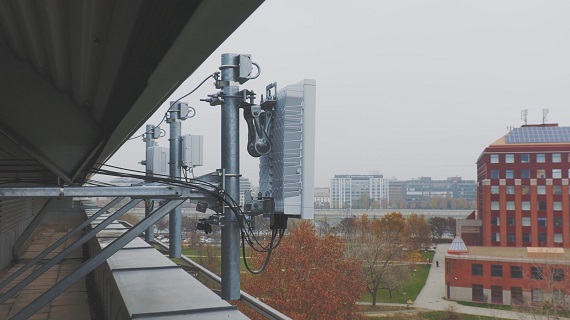Telekom, BME and Ericsson to launch a joint research on 5G
Within the frame of the cooperation, Magyar Telekom assigns 20MHz from its 3600MHz band and 10MHz from its 2600MHz band to the Budapest University of Technology and Economics from its own frequency range, free of charge, for R&D purposes. With the use of the frequencies temporarily provided by Magyar Telekom, Ericsson Hungary operates a 5G test network in BME’s “I” building and in the research laboratory of Ericsson's R&D center. The test network is planned to operate both in NSA (non-standalone, i.e. built on 4G) as well as SA (standalone) mode - the latter allowing an even broader use case support, thus leveraging the R&D activities on the full potential of the 5G technology. The local 5G test network has restricted access and can only be used by BME’s designated lecturers and students, as well as the two company’s staff in charge of the planned activities. The applications and solutions developed on the test network are presented jointly by the involved parties.

“Despite the pandemic situation, technological developments need to continue. This is the area where there is no stopping, you may not be left behind. Today, digitalization has become a key factor in our daily lives. This is why the Hungarian Government welcomes the development and capacity offers that are suitable for professionals to develop innovative solutions that increase the comfort of the population and have a positive impact on the economy. 5G technology can make life easier for all of us, but in order to take full advantage of the benefits of mobile broadband, we need to develop services and products, and that requires test networks. Among the Hungarian higher education institutions, BME is one of the most prominent universities where the latest, state-of-the-art solutions based on 5G technology are designed and successfully tested, so I think we can soon experience the fruits of this cooperation” - emphasized dr. Károly Balázs Solymár, Deputy State Secretary for Digitization of the Ministry of Innovation and Technology.
Lubor Zatko, Telekom’s Chief Technical Officer commented on the cooperation as follows: “The next generation 5G mobile technology brings not only new opportunities for consumers, but also helps industry, logistics, agriculture and many other verticums to step up to a much higher level of digitalization than ever before. However, this requires solutions and applications that can take advantage of the outstanding features of 5G technology, and thus create added value. To ensure that 5G networks deliver such tangible benefits both from a business and economic perspective, using Magyar Telekom’s network, T-Systems Hungary is working on concrete business solutions, among others, in the field of industry and transportation. We are proud that we do not only continuously increase the domestic coverage of our 5G network, but with the recently announced cooperation we also support educational and research objectives that help us to explore actual usage needs and to find solutions that may be used by our customers in the future.”
Dr. János Józsa, Rector of the Budapest University of Technology and Economics said: “We are pleased that thanks to Magyar Telekom and Ericsson a complex 5G test infrastructure has been set up in the “I” building, which can support the university's R&D activities. The network is used by the consortium of Ericsson Hungary and the BME’sTelecommunications and Media Infocommunications Department
“The consortium established by BME and Ericsson launched a project to develop 5G software and pilot applications already in 2019, which represents a new dimension in the decades-long cooperation between Ericsson and BME. As part of the project Ericsson has built a complete 5G test network that will operate both indoors and outdoors in the BME’s “I” building and is also accessible in the research laboratory of Ericsson's R&D center. On the new 5G test network one may test applications, use cases and functions that are not yet available on a live network. The significance of this development is that the testing of software under development can be started at an early stage, which significantly speeds up the market entry of an application” - said Roland Jakab, Head of Strategy Central Europe, Ericsson.
Case studies presented at the online media event
Available: here
5G and smart farming
Agricultural use cases are characterized by the joint application of low-bandwidth sensor data, real-time traffic control and high-resolution video streams. This traffic mix generates a need for coverage by Quality of Service (QoS) solutions in large areas. The ultimate goal is to increase the automation of agricultural activities and their efficiency while managing their underlying risks. Our scenarios include activities that require advanced technology, such as the collaboration of cooperative drone groups or artificial intelligence applied to predictive analytics. Outdoor activities in smart agriculture are characterized by a changing environment, thus the services need to adapt to this dynamic environment. The accurate and continuous soil and crop monitoring system equipped with a large number of IoT sensors continuously supplies input data. The artificial intelligence supports automated decision-making processes that rely on this data stream and makes it available as a virtualized network service. The traffic providing time-critical control of devices working on fields co-exists with high-definition video streams, so 5G network slicing must be used to serve processes that have very different characteristics.
-Cloud-controlled drone:The drone transmits video to the IT cloud with its camera in flight. The camera image is analyzed by the server, the system locates the drone and recognizes the objects in the image. Objects are recognized in the cloud with low latency and high accuracy with the use of artificial intelligence and large-scale models. The drone is controlled from the cloud and a map is created based on the markers recognized in the image, which is used by the drone for localization during its flight. Based on the video connection the drone requires low-latency and high-bandwidth network access, however, as the computation process takes place in the cloud, the drone does not require the installation of a high-performance, small size computer. During the demo the drone flies indoors and maps the area with the use of markers. The drone then flies in a route controlled from the server and detects objects in the environment. The flight is automated and the user can monitor it in a browser interface. The user has almost no possibility of intervention, only in cases of start and an emergency stop.
-Intelligent bird voice identification system:A smart agricultural (outdoor) use-case demonstrates the benefits of efficient cloud-native services supported by 5G systems. The system monitors the environment with outdoor microphones and classifies all noise locally. For this purpose, it uses second based sound samples, which are separated into categories with the use of artificial intelligence. If it classifies the sound sample as a bird chirp, it transmits it to the cloud-based 5G system, where a complex neural network based artificial intelligence recognizes if the sound sample comes from starlings. In the event of a positive result the system activates the alarm, which will be the sound of a bird of prey played from an outdoor speaker. Artificial intelligence-based solutions require a lot of computing, so in our solution we paid special attention to take advantage of the benefits provided by the cloud. The architecture of our solution follows the principle of micro-services, which can be integrated into 5G systems as virtual network services.
5G-supported smart manufacturing
Industry 4.0 complex processes rely on the 5G system’s low-latency connections. In 5G-supported smart manufacturing human intervention must be minimized and robots must be controlled in an agile and flexible manner. Complex manufacturing processes are implemented by cooperating robots, for which accurate positioning and low latency communication are essential. It is of key importance to minimize hazards related to the use of robots to protect humans and to avoid damage. Therefore, we integrate sensor data into the process evaluation and control. The evaluation of data with artificial intelligence increases security and efficiency. In 5G systems the edge computing has been introduced to support control and analytical tasks in cases where the task is performed by an IT unit located close to the user.
-Collaborating robots in the cloud:The demo shows a network-controlled, industrial robot arm that can cooperate intelligently with the user. The user can perform a task with the help of the robot arm, supporting and performing certain subtasks of the workflow. The robot is controlled from the network, taking advantage of the 5G cloud architecture, demonstrating the possibility of cloud-based, real-time robot control.
-Industrial automation with 5G and cloud support:Most automated industrial devices used in factories perform a pre-programmed sequence of actions. Robots have no knowledge of the current state of the world around them. In the Industry 4.0 concept, the manufacturing process needs to be much more flexible compared to the systems used today. This requires flexible tools that can be quickly reconfigured and easily controlled. Robotic devices must be able to operate with an increasing degree of automation - they must respond quickly and appropriately to external events. The introduction of 5G and cloud-based intelligence will help solve these problems, enabling robots to work together even on tasks that require very low latency. This is especially important for mobile robots, as they cannot be connected by cable. With the 5G network and cloud-based control, we can create centralized logic that can optimize the path of mobile robots by combining the information detected by each device. In addition, the construction of robots will be much simpler, as there is no need to perform calculations on the devices, which also makes them cheaper in the long run.
